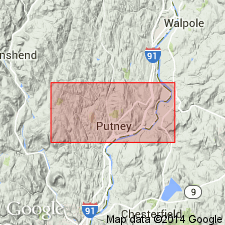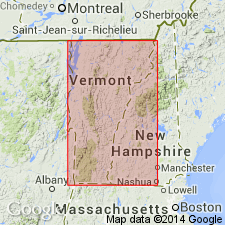
- Usage in publication:
-
- Black Mountain granite
- Modifications:
-
- Areal extent
- AAPG geologic province:
-
- New England province
Summary:
Pg. 349-357, in description of Putney Township. Black Mountain granite. Acid intrusives are not present in this township, but in Dummerston Township, first township to south, they include the well-known Black Mountain granite. [Black Mountain is in Brattleboro quadrangle, Windham County, southeastern Vermont.] Age is unknown.
Source: US geologic names lexicon (USGS Bull. 896, p. 204).

- Usage in publication:
-
- Black Mountain Granite*
- Modifications:
-
- Geochronologic dating
- AAPG geologic province:
-
- New England province
Summary:
Black Mountain Granite (Hepburn and others, 1984) intrudes core of rocks of Guilford dome approx 15 km east of Athens and Rayponda domes where it is regarded as an Acadian syntectonic intrusive. Age determined as 373+/-4 Ma based on U-Pb zircon studies by J.N. Aleinikoff (1992, pers. commun.); this age compares favorably with 372+/-5 Ma Rb-Sr whole-rock isochron of Naylor (1971). However, age doesn't support 326+/-17 Rb-Sr whole-rock age of Hayward and others (1989), which could have required post-Acadian deformation in the area of Guilford dome.
Source: GNU records (USGS DDS-6; Reston GNULEX).
For more information, please contact Nancy Stamm, Geologic Names Committee Secretary.
Asterisk (*) indicates published by U.S. Geological Survey authors.
"No current usage" (†) implies that a name has been abandoned or has fallen into disuse. Former usage and, if known, replacement name given in parentheses ( ).
Slash (/) indicates name conflicts with nomenclatural guidelines (CSN, 1933; ACSN, 1961, 1970; NACSN, 1983, 2005, 2021). May be explained within brackets ([ ]).

